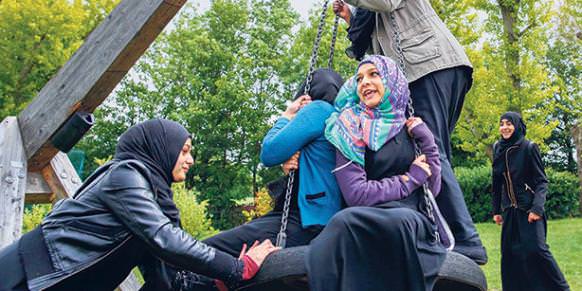Challenging the idea of being oppressed to don hijab, a growing number of young British Muslim women are choosing to wear the Islamic veil or hijab, despite figures showing rising violence against visibly identifiable Muslims.
“I’m going to stand out whatever I do, so I might as well wear the headscarf,” Sumreen Farooq, a shop assistant who also volunteers at an Islamic youth centre in Leyton, east London, told Reuters.
The 18-year-old Muslim decided to don hijab to declare their faith to all around her after being abused in a London street.
While just under five percent of Britain’s 63 million population are Muslim, there are no official numbers on how many women wear a headscarf or head veil, known as the hijab, or the full-face veil, the niqab, which covers all the face except the eyes. The niqab is usually worn with a head-to-toe robe or abaya.
But anecdotally it seems in recent years that more young women are choosing to wear a headscarf to assert a Muslim identity they feel is under attack and to publicly display their beliefs.
Shanza Ali, 25, a Masters graduate who works for a Muslim-led non-profit organisation in London, said she was born in Pakistan and her Pakistani mother had never worn the veil but both she and her sister Sundas chose to do so aged about 20.
“I decided to make a commitment as a Muslim and I have never stopped since,” Shanza told Reuters in her family home in Walthamstow, east London where prayer mats hang from the walls alongside modern, family portraits.
“Sometimes you forget that you’re covering your hair but you never forget why you’re covering. You remember, that to you, your character should be more important than your appearance.
“It makes it easier for Muslim women to keep away from things that you don’t want to do that would impact your value system. If you don’t want to go clubbing, drink, or have relations outside marriage, it can help, but it can also just be a reminder to be a good person and treat others well.”
STANDING OUT IN A CROWD
Shaista Gohir, chairman of the Muslim Women’s Network UK, said more women had adopted headscarves since the attacks in the United States on Sept. 11, 2001, and in London on July 7, 2005, put them under greater political and public scrutiny.
“For some young women it is a way of showing they are different and they are Muslim although it is not a Muslim obligation,” she told Reuters.
She said the full-face niqab was a minor phenomenon in Britain, worn by relatively few women, although it had become central to a wider debate in the country about integration and British values.
This was put to the test last year when a judge ruled a Muslim woman could not give evidence at a trial wearing a niqab, sparking debate about whether Britain should follow other European countries and ban full-face veils in public places.
After a national debate, a compromise was reached and it was agreed that the woman could wear the niqab during the trial but not when she was giving evidence.
Modesty in Islam is key for both men and women but most Islamic scholars agree that women adopting a full-face veil is more to do with culture than religion.
But women who publicly display their religion by wearing a scarf of any kind have found they can be targeted for doing so.
Figures released recently from the campaign group Tell MAMA (Measuring Anti-Muslim Attacks) showed the number of attacks against Muslims in Britain was one the rise.
During its first year of monitoring, Tell MAMA recorded 584 anti-Muslim incidents between April 1 2012 and April 30 2013, with about 74 percent of these taking place online.
Of the physical incidents, six in 10, or 58 percent, were against Muslim women and 80 percent of women targeted were visually identifiable by wearing a hijab or niqab.
The number rose to 734 incidents over the 10 months from Mary 2013 to February 2014 with 54 percent of these against women and a total of 599 online. There was a spike in reports in the weeks following the murder of off-duty soldier Lee Rigby in south London in May last year by two British Muslim converts.
“Attacks against visibly dressed Muslim females may not accurately explain away the trend of hate crimes being opportunistic and situational. The data suggests that the alleged perpetrators of anti-Muslim hate crimes at a street-based level, are young white males targeting Muslim women, and that is a cause for concern,” Tell MAMA said in a statement.
Matthew Feldman, co-founder of the Centre for Fascist, Anti-Fascist and Post-Fascist Studies at Teesside University who analyses Tell MAMA data, said the rise in the numbers of attacks could be partly due to more awareness of the reporting process.
“But there is a slight bump in the occurrence of people wearing more visible dress and of victims being women rather than men,” Feldman told Reuters.
“We are seeing an unacceptable rise in the level of anti-Muslim attacks but it does seem there is a pretty small number of violent, hardcore far-right people responsible for a high number of these.”
Agencies/Canadajournal
 Canada Journal – News of the World Articles and videos to bring you the biggest Canadian news stories from across the country every day
Canada Journal – News of the World Articles and videos to bring you the biggest Canadian news stories from across the country every day



